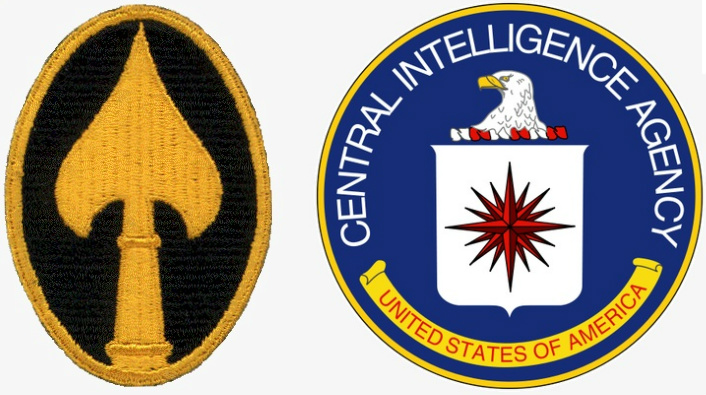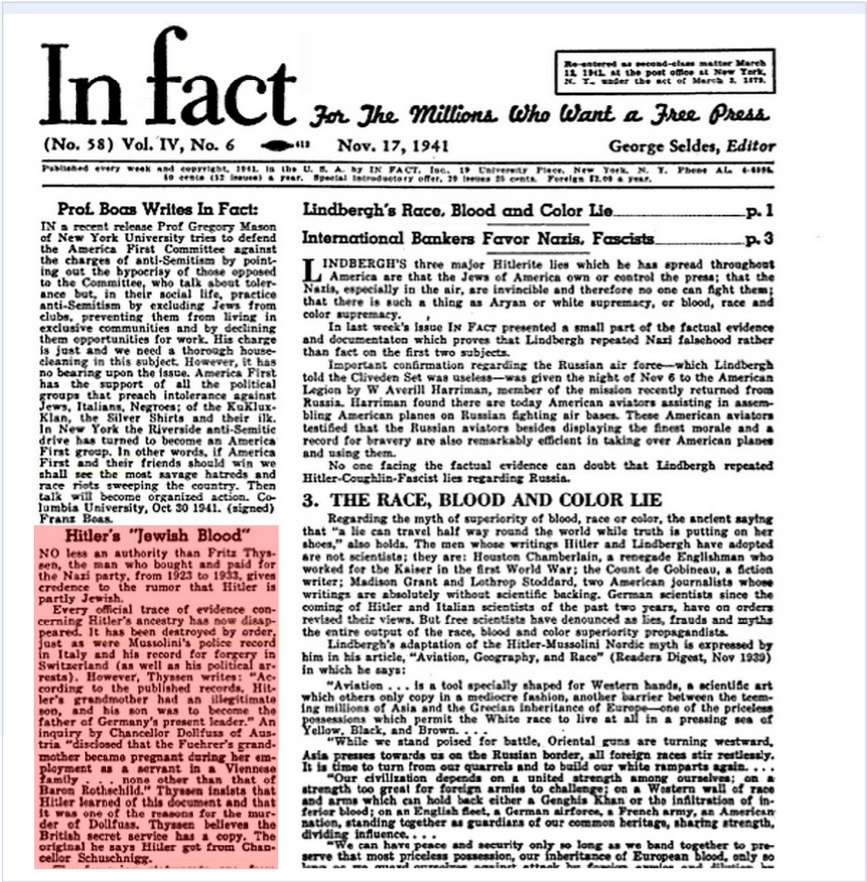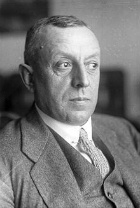
In 1943 the Office of Strategic
Services, the forerunner of the CIA,
instigated a psychological
profile of Adolf Hitler, which was
completed by some of America's leading
psychologists.
The report spent much time discussing
the rumours of Hitler's Jewish ancestry,
including
that Hitler may be the grandson of one
of the Rothschild banking dynasty.
.
In Fact "a
four-page weekly compendium
of news other newspapers
wouldn't print."
From the November 17, 1941
edition
Hitler's "Jewish
Blood"
NO less an
authority than
Fritz Thyssen,
the man who
bought and paid
for the Nazi
party, from 1923
to 1933, gives
credence to the
rumor that
Hitler is partly
Jewish.
Every official
trace of
evidence
concerning Every
official trace
of evidence
concerning
Hitler's
ancestry has now
disappeared. It
has been
destroyed by
order, just as
were Mussolini's
police record in
Italy and his
record for
forgery in
Switzerland (as
well as his
political
arrests).
However, Thyssen
writes:
"According to
the published
records,
Hitler's
grandmother had
an illegitimate
son, and this
son was to
become the
father of
Germany's
present leader."
An inquiry by
Chancellor
Dollfuss of
Austria
"disclosed that
the Fuehrer's
grandmother
became pregnant
during her
employment as a
servant in a
Viennese family
. . . none other
than that of
Baron
Rothschild."
Thyssen insists
that Hitler
learned of this
document and
that it was one
of the reasons
for the murder
of Dollfuss.
Thyssen believes
the British
secret service
has a copy. The
original he says
Hitler got from
Chancellor
Schuschnigg.
The
foregoing
statements
are from
Thyssen's
amazing
book, "I
Paid Hitler"
(Farrar &
Rinehart,
NYC, $2.75).
The best
part of this
volume
details the
financing of
Hitlerism by
by German
and American
industry and
bankers. In
Fact
recommends
this book, a
real inside
story of
Naziism).
click image to
enlarge

 German
industrialist Fritz Thyssen,
later distanced himself from
the book I
Paid Hitler, which
was
German
industrialist Fritz Thyssen,
later distanced himself from
the book I
Paid Hitler, which
was
actually written by
Emery Reves, whilst Thyssen,
an ex-Nazi, was in German
concentration camp.
 Emery
Reves (Rosenbaum), a Hungarian Jew, was
Winston Churchill's friend, & publishing
agent since 1937.
Emery
Reves (Rosenbaum), a Hungarian Jew, was
Winston Churchill's friend, & publishing
agent since 1937.
"I have long thought very highly
of Mr. Reves' abilities in all that
concerns propaganda and the
handling of the neutral press."
- Winston Churchill, June 30, 1940
Why did a Jew, a very well connected
Jew, spread
the rumour that Hitler was a
Rothschild?

 Emery
Reves (Rosenbaum), a Hungarian Jew, was
Winston Churchill's friend, & publishing
agent since 1937.
Emery
Reves (Rosenbaum), a Hungarian Jew, was
Winston Churchill's friend, & publishing
agent since 1937.




































I say this not as somebody interested in "discrediting" Hitler, but as somebody interested in historical fact.
ReplyThe case of Thyssen is more complicated than Reeves writing a book and Thyssen being wrongly accused of actions he did not commit. Antony Sutton notes, in "America's Secret Establishment": http://www.bibliotecapleyades.net/sociopolitica/esp_sociopol_skullbones11f.htm
"The records of the U.S. Control Council for Germany contain the post-war intelligence interviews with prominent Nazis. From these we have verification that the major conduit for funds to Hitler was Fritz Thyssen and his Bank fur Handel and Schiff, previously called von Heydt's Bank. This information coincides with evidence in Wall Street And The Rise Of Hitler and Hitler's Secret Backers, even to the names of the people and banks involved, i.e., Thyssen, Harriman, Guaranty Trust, von Heydt, Carter, and so on.
The document reproduced on page 167 below, slipped through U.S. censorship because the Office of Director of Intelligence did not know of the link between Fritz Thyssen and the Harriman interests in New York.
Documents linking Wall Street to Hitler have for the most part been removed from U.S. Control Council records. In any event, we reproduce here the Intelligence report identifying Fritz Thyssen and his Bank fur Handel und Schiff (No. EF/Me/1 of September 4, 1945) and page 13 of the interrogation of Fritz Thyssen entitled "Financial Support of the Nazi Party."
[...]
This flow of funds went through Thyssen banks. The Bank fur Handel and Schiff cited as the conduit in the U.S. Intelligence report was a subsidiary of the August Thyssen Bank, and founded in 1918 with H.J. Kouwenhoven and D.C. Schutte as managing partners. In brief, it was Thyssen's personal banking operation, and affiliated with the W.A. Harriman financial interests in New York.
Thyssen reported to his Project Dustbin interrogators that:
"I chose a Dutch bank because I did not want to be mixed up with German banks in my position, and because I thought it was better to do business with a Dutch bank, and I thought I would have the Nazis a little more in my hands."
Hitler's Secret Backers identifies the conduit from the U.S. as "von Heydt," and von Heydt's Bank was the early name for Thyssen's Bank. Furthermore, the Thyssen front bank in Holland - i.e., the Bank voor -iandel en Scheepvaart N.V. - controlled the Union Banking Corporation in New York."
Of relevance is the following: http://reformed-theology.org/html/books/wall_street/chapter_10.htm
Sutton, in the chapter in "America's Secret Establishment" linked to above, also noted the following:
Reply"Chase Manhattan Bank is not only a firm that plays both sides of the political fence, but with Ford Motor Company, was selected by Treasury Secretary Morgenthau for post-war investigation of pro-Nazi activities: These two situations [i.e., Ford and Chase Bank] convince us that it is imperative to investigate immediately on the spot the activities of subsidiaries of at least some of the larger American firms which were operating in France during German occupation ...
The extent of Chase collaboration with Nazis is staggering - and this was at a time when Nelson Rockefeller had an intelligence job in Washington aimed AGAINST Nazi operations in Latin America.
In December 1944 Treasury Department officials examined the records of the Chase Bank in Paris. On December 20, 1944 the senior U.S. examiner sent a memorandum to Treasury Secretary Morgenthau with the preliminary results of the Paris examination.
Here's an extract from that report:
Niederman, of Swiss nationality, manager of Chase, Paris, was unquestionably a collaborator;
The Chase Head Office in New York was informed of Niederman's collaborationist policy but took no steps to remove him. Indeed there is ample evidence to show that the Head Office in New York viewed Niederman's good relations with the Germans as an excellent means of preserving, unimpaired, the position of the Chase Bank in France.
The German authorities were anxious to keep the Chase open and indeed took exceptional measures to provide sources of revenue.
The German authorities desired "to be friends" with the important American banks because they expected that these banks would be useful after the war as an instrument of German policy in the United States.
The Chase, Paris showed itself most anxious to please the , German authorities in every possible way. For example, the Chase zealously maintained the account of the German Embassy in Paris, "as every little thing helps" (to maintain the excellent relations between Chase and the German authorities).
The whole objective of the Chase policy and operation was to maintain the position of the bank at any cost. In brief, Chase Bank was a Nazi collaborator, but the above preliminary report is as far as the investigation proceeded. The report was killed on orders from Washington, D.C.
On the other hand, Chase Bank, later Chase Manhattan Bank, has been a prime promoter of exporting U.S. technology to the Soviet Union. This goes all the way back to the early 1920s when Chase broke U.S. regulations in order to aid the Soviets. As early as 1922 Chase was trying to export military LIBERTY aircraft engines to the Soviet Union!
In conclusion, we have seen that the two arms of the dialectic described in Memoranda Three and Four clashed in World War II. Furthermore, the corporate segment of the elite profited from Lend Lease to the Soviets and by underground cooperation with Nazi interests."
On WWII being a managed conflict, Mullins provides great insight: http://modernhistoryproject.org/mhp?Article=WorldOrder&C=3.0#Conflict
http://www.ifz-muenchen.de/heftarchiv/1971_3_1_turner.pdf
Reply